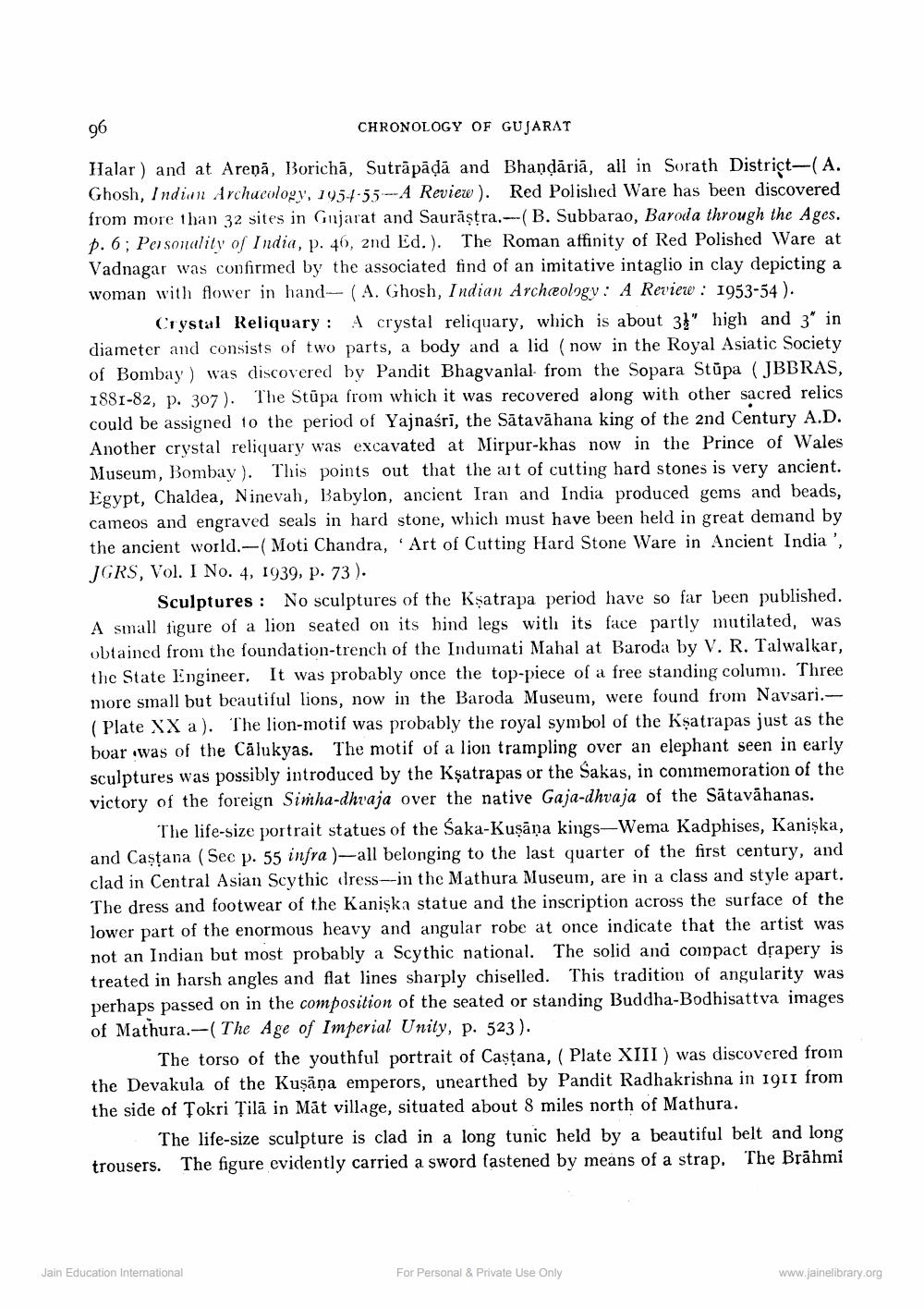________________
96
CHRONOLOGY OF GUJARAT
Halar) and at Arenā, Borichā, Suträpädä and Bhandāriā, all in Sorath District-(A. Ghosh, Indian Archaeology, 1954-55-A Review). Red Polished Ware has been discovered from more than 32 sites in Gujarat and Saurāstra.---(B. Subbarao, Baroda through the Ages. p. 6; Personality of India, p. 46, 2nd Ed.). The Roman affinity of Red Polished Ware at Vadnagar was confirmed by the associated find of an imitative intaglio in clay depicting a woman with flower in hand- (A. Ghosh, Indian Archeology: A Review : 1953-54).
Crystal Reliquary : A crystal reliquary, which is about 3}" high and 3" in diameter and consists of two parts, a body and a lid (now in the Royal Asiatic Society of Bombay) was discovered by Pandit Bhagvanlal from the Sopara Stūpa (JBBRAS, 1881-82, p. 307). The Stupa from which it was recovered along with other sacred relics could be assigned to the period of Yajnaśrī, the Sātavāhana king of the 2nd Century A.D. Another crystal reliquary was excavated at Mirpur-khas now in the Prince of Wales Museum, Bombay). This points out that the art of cutting hard stones is very ancient. Egypt, Chaldea, Ninevah, Babylon, ancient Iran and India produced gems and beads, cameos and engraved seals in hard stone, which must have been held in great demand by the ancient world.-(Moti Chandra, 'Art of Cutting Hard Stone Ware in Ancient India', JGRS, Vol. I No. 4, 1939, P. 73).
Sculptures : No sculptures of the Ksatrapa period have so far been published. A small figure of a lion seated on its hind legs with its face partly mutilated, was obtained from the foundation-trench of the Indumati Mahal at Baroda by V. R. Talwalkar, the State Engineer. It was probably once the top-piece of a free standing column. Three more small but beautiful lions, now in the Baroda Museum, were found from Navsari.(Plate XX a). The lion-motif was probably the royal symbol of the Ksatrapas just as the boar was of the Cālukyas. The motif of a lion trampling over an elephant seen in early sculptures was possibly introduced by the Kşatrapas or the Sakas, in commemoration of the victory of the foreign Simha-dhraja over the native Gaja-dhvaja of the Sātavāhanas.
The life-size portrait statues of the Saka-Kuşāņa kings-Wema Kadphises, Kaniska, and Castana (See p. 55 infra )-all belonging to the last quarter of the first century, and clad in Central Asian Scythic dress--in the Mathura Museum, are in a class and style apart. The dress and footwear of the Kaniska statue and the inscription across the surface of the lower part of the enormous heavy and angular robe at once indicate that the artist was not an Indian but most probably a Scythic national. The solid and compact drapery is treated in harsh angles and flat lines sharply chiselled. This tradition of angularity was perhaps passed on in the composition of the seated or standing Buddha-Bodhisattva images of Mathura.--( The Age of Imperial Unity, p. 523).
The torso of the youthful portrait of Castana, ( Plate XIII) was discovered from the Devakula of the Kuşāņa emperors, unearthed by Pandit Radhakrishna in 1911 from the side of Tokri Țilā in Māt village, situated about 8 miles north of Mathura.
The life-size sculpture is clad in a long tunic held by a beautiful belt and long trousers. The figure evidently carried a sword fastened by means of a strap. The Brāhmi
Jain Education International
For Personal & Private Use Only
www.jainelibrary.org




